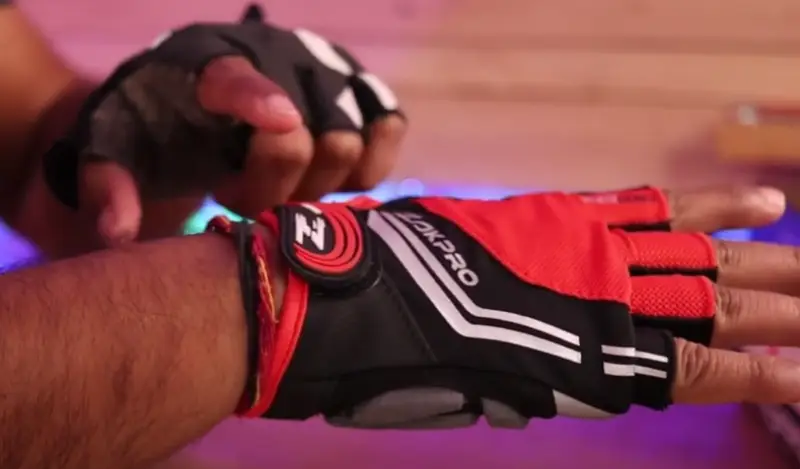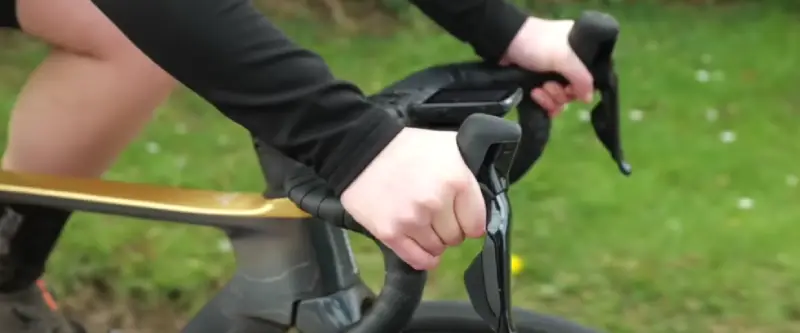The radial, median, or ulnar nerve are likely to be compressed when cycling, causing hand numbness. You’re probably not consciously squeezing yourself, but a few default bike positions can inevitably cause it.
Cyclist’s Numbness is generally treated with temporary braces, anti-inflammatory medications, and hand therapy. Mild cases can ride while optimizing their bicycle ergonomics, including seat height, handlebar thickness, aero bars, and gloves.
We will explore various treatment options for cycling hand numbness, including ergonomic handlebars, hand exercises, bike fit adjustments, medical treatment options, and prevention techniques.
Cycling Hand Numbness Treatment: 7 Proven Remedies

Hand numbness is often caused by poor bike fit and improper handling techniques that put too much pressure on the hands and wrists. We will explore effective cycling hand numbness treatments:
Specific Term: Ergonomic Handlebars
Ergonomic handlebars are specifically designed to reduce hand numbness by optimizing the hand position on the handlebars.
These handlebars provide a more natural grip, allowing the wrists to remain neutral and preventing undue pressure on the ulnar and median nerves in the hand. Ergonomic handlebars benefit long-distance cyclists or those with existing hand pain or injuries.
Benefits of ergonomic handlebars include:
- Reduces pressure on hands and wrists: Ergonomic handlebars are designed to promote a natural grip, reducing hand and wrist pressure and preventing numbness.
- Improving comfort and control: By optimizing the hand position, ergonomic handlebars can improve comfort and control while cycling, allowing cyclists to maintain a steady pace and reduce fatigue.
- Preventing injuries: The neutral wrist position promoted by ergonomic handlebars can prevent injuries such as carpal tunnel syndrome, as well as reduce strain on the neck, shoulders, and upper back.
Types of Ergonomic Handlebars
- Drop bars: Curved handlebars are traditional on-road bikes. They offer a range of hand positions and aerodynamic benefits. They can put significant pressure on your palms and wrists.
- Flat bars: Mountain, hybrid, and commuter bikes have straight handlebars. They allow for a more upright, relaxed riding position but can also cause limitations in hand movement and numbness.
- Riser bars: Flat bars with a slight upward curve. They offer a comfortable and natural riding position but reduce aerodynamics and speed.
- Butterfly bars: With their complex shape similar to a butterfly or figure-eight, these bars can be angled and positioned in a wide range of ways but are often heavy and bulky.
- Mustache bars: Simple in design, they offer a moderate range of hand positions and angles but can be awkward and narrow.
Pick Ergonomic Handlebars Based on These Factors:
- Riding style: Different handlebars are better suited to different types of cycling, so it’s essential to consider your primary riding style when selecting ergonomic handlebars.
- Weight and durability: Ergonomic handlebars should be sturdy enough to withstand regular use but lightweight enough to minimize the impact on bike performance.
- Compatibility: Some handlebars may not be compatible with your current bike, so checking your bike’s specifications before purchasing new handlebars is essential.
Installing Ergonomic Handlebars
- Consider professional installation: You may benefit from professional installation if you install ergonomic handlebars with existing components on a bike.
- Adjust the stem height: Your current handlebars may need to be adjusted to accommodate ergonomic handlebars.
- Check component compatibility: Make sure your new handlebars are compatible with your existing brake levers and shifters, or purchase new ones if necessary.
Specific Term: Hand Exercises
Exercises for the hands improve blood flow and flexibility, preventing and treating hand numbness. You can perform these exercises before or after cycling or during long rides. Activities for the hands are particularly beneficial for cyclists who grip the handlebars continuously and those with existing hand and wrist conditions.
Benefits of Hand Exercises Include:
- Increasing blood flow: Hand exercises increase blood flow to the hands, preventing nerve compression and numbness.
- Improving flexibility and range of motion: Cycling cyclists can maintain a firmer grip on the handlebars by increasing their hands’ flexibility and range of motion.
- Strengthening hand and wrist muscles: Hand exercises can improve hand function and reduce fatigue and strain by strengthening the muscles in the hands and wrists.
Types of Hand Exercises

- Finger bends: Make a fist with your hand, then open your fingers as wide as possible. You should repeat this several times.
- Wrist rotations: Hold your arm out straight and rotate your wrist in circular motions. Repeat several times in each direction.
- Grip squeezes: Squeeze a small ball or grip device in your hand, holding the squeeze for a few seconds before releasing it. Repeat several times.
Cyclists should perform hand exercises at least once daily, ideally before and after cycling. Each exercise should be repeated 10-15 times per session and held for a few seconds.
Specific Term: Bike Fit Adjustments
Bike fit adjustments are the key to the perfect riding position, reducing pressure on your hands and preventing hand numbness. Poor bike fit can cause discomfort, such as back pain or saddle sores. Proper bike fit adjustments can:
- Improve riding comfort and efficiency.
- Increase power and speed.
- Decrease the risk of injury.
- Reduce hand numbness.
Types of Bike Fit Adjustments
There are several bike fit adjustments you can make to minimize hand numbness, including:
- Adjusting saddle height.
- Changing saddle position.
- Adjusting handlebar height and reach.
- Altering stem length and angle.
Bike Fit Adjustment Steps
To determine the correct bike fit adjustment, follow these steps:
- Identify the problem area (e.g., hand numbness).
- Evaluate your riding style and bike setup.
- Determine the source of the problem (e.g., improper handlebar height).
- Make the necessary adjustments and test it on your next ride.
- Check for improvements and make further adjustments if necessary.
Cycling Hand Numbness: Medical Treatment
Cycling hand numbness treatment options aim to address the underlying causes of this condition. Depending on your symptoms, you may be prescribed medication, injections, or surgery. These options target the source of your numbness, which can be due to nerve compression, inflammation, or injury.
Types of Medical Treatment Options
Here are some of the cycling hand numbness treatments that your doctor may recommend:
- Medications: Anti-inflammatory drugs, painkillers, or nerve blockers can alleviate the swelling, pain, or nerve signals that lead to your symptoms.
- Injections: Corticosteroids, botulinum toxin, or local anesthetics can relieve pressure, inflammation, or numbness in your hand.
- Surgery: Your doctor may advise treating nerve compression, fractures, or tumors. Surgery can decompress the nerve, repair the bone, or remove the growth that triggers the numbness.
Cycling Hand Numbness: Signs of Medical Treatment
You should consult your doctor if you experience any of the following symptoms:
- Your cycling hand numbness continues for over a few weeks or recurs frequently.
- Your cycling hand numbness affects your daily activities, such as typing, writing, or holding objects.
- Other symptoms, such as weakness, tingling, burning, or loss of sensation in your hand, accompany your cycling hand numbness.
- Your cycling hand numbness results from trauma, such as a fall, a crash, or a cut.
Pros and Cons of Medical Treatment Options
Like any medical intervention, cycling hand numbness treatments have advantages and disadvantages. Here are some of the pros and cons to consider:
Pros
- Medical treatment options can alleviate your cycling hand numbness and prevent further complications, such as nerve damage, infection, or disability.
- Depending on your treatment, you can experience immediate and long-term relief from your symptoms.
Cons
- Medical treatment options can have side effects, such as bleeding, bruising, infection, or allergic reactions.
- The procedure can be invasive, painful, or expensive, depending on your treatment.
- Recovery time may be necessary after your medical treatment.
Hand Numbness Treatment While Cycling: 7 Prevention Tips

Cycling is an exciting activity combining fitness and adventure, but persistent hand numbness can damper the joy of riding. We’ll explore practical solutions to prevent and treat cycling hand numbness, ensuring you can enjoy every pedal without discomfort.
Wearing Gloves
- Choose well-padded cycling gloves to minimize pressure on your hands.
- Ensure a snug fit for optimal protection without compromising blood circulation.
- Consider gloves with gel padding to absorb shocks and reduce vibrations.
Changing Hand Positions
- Regularly shift your hand positions on the handlebars to distribute pressure evenly.
- Alternate between the tops, hoods, and drops to engage different muscle groups.
- Experiment with grip variations to find the most comfortable hand placement.
Adjusting the Bike
- Fine-tune your bike’s saddle height and angle for a natural hand position.
- Ensure proper bike frame size and handlebar reach to prevent overreaching.
- Check and adjust your bike’s suspension to absorb road vibrations effectively.
Using Ergonomic Grips and Padding
- Explore ergonomic grip options designed to reduce stress on your hands.
- Add bar tape or grips with extra padding to dampen vibrations from rough terrains.
- Consider installing anti-vibration inserts for handlebars to minimize impact.
Stretching
- Incorporate pre-ride hand stretches to improve flexibility and reduce tension.
- Perform simple hand exercises during breaks to maintain blood circulation.
- Stretch your fingers, wrists, and forearms regularly to alleviate stiffness.
Strengthening the Core
- Exercises that strengthen your core alleviate pressure on your hands.
- Engage in core workouts such as planks and bicycle crunches to enhance stability.
- A robust core helps distribute body weight evenly, reducing hand strain.
Regular Breaks During Cycling
- Schedule breaks during longer rides to allow your hands to rest and recover.
- Use breaks to perform gentle hand stretches and shake off any accumulated tension.
- Hydrate, refuel and take a moment to assess your overall comfort during breaks.
Conclusion
Cycling hand numbness is a significant issue for cyclists, affecting their comfort and performance on the bike. Several treatment options are available for this problem, from ergonomic handlebars to medical treatment options. The most important thing is to prevent cycling hand numbness from happening in the first place.
You can keep cycling hand numbness at bay by taking regular breaks, wearing gloves, adjusting your bike, and performing hand exercises. The benefits of addressing cycling hand numbness are significant – you’ll experience fewer distractions and have a more enjoyable ride. Remember, taking care of your hands while cycling is just as crucial as taking care of any other body part.
FAQs
What Causes My Fingers to Feel Numb After Cycling?
When the ulnar sensory nerve is prolongedly compressed, handlebar palsy causes your hand to ache and your ring and little fingers to feel numb. A person with carpal tunnel syndrome may have pain in their wrists because of compression of the median nerve within the “tunnel” between the bones.


